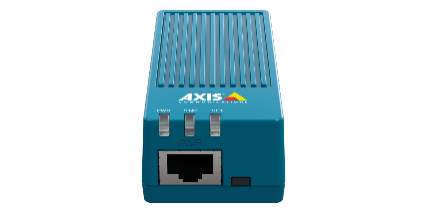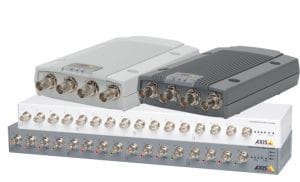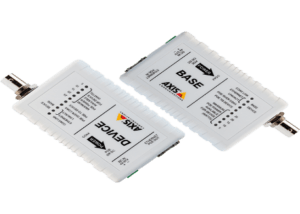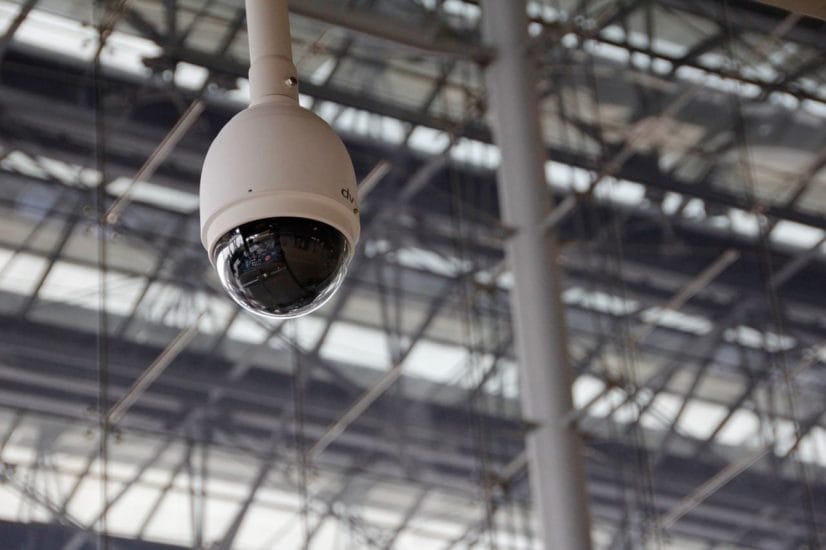Upgrading to an IP Camera System from a CCTV Analog Camera System can be done many ways. The first is a complete new solution consisting of new category 6 cabling, IP Security Cameras, Video Server with Video Management Software (VMS) such as Milestone and PoE Switches. This is the optimal solution but isn’t affordable for everyone.
A good time to consider upgrading is when your recorder (DVR) fails and you need a new one or when you are expanding from a 16 channel recorder to a 32 channel recorder. The cost of a new DVR can be expensive. At this point you can get a quote for a new IP Camera System Server and opt for encoders so that you are able to use the existing CCTV security cameras and coaxial cabling.

Single Channel Encoder

Multi-Channel Video Encoders
What are Video Encoders? Video encoders, also known as video servers, enable an existing analog CCTV video surveillance system to be integrated with a network video system. Video encoders play a significant role in installations where many analog cameras are to be maintained.
A video encoder makes it possible for an analog CCTV system to migrate to a network video system. It enables users to gain the benefits of network video without having to discard existing analog equipment such as analog CCTV cameras and coaxial cabling.
A video encoder connects to an analog video camera via a coaxial cable and converts analog video signals into digital video streams that are then sent over a wired or wireless IP-based network (e.g., LAN, WLAN or Internet). To view and/or record the digital video, computer monitors and PCs can be used instead of DVRs or VCRs and analog monitors. By using video encoders, analog video cameras of all types, such as fixed, indoor/outdoor, dome, pan/tilt/zoom, and specialty cameras such as highly sensitive thermal cameras and microscope cameras can be remotely accessed and controlled over an IP network.
A video encoder also offers other benefits such as event management and intelligent video functionalities, as well as advanced security measures. In addition, it provides scalability and ease of integration with other security systems.
A one-channel, standalone video encoder with audio, I/O (input/output) connectors for controlling external devices such as sensors and alarms, serial ports (RS-422/485) for controlling PTZ analog cameras and Ethernet connection with Power over Ethernet support.
Switching to an IP Video server rather than replacing with another DVR allows you to keep the CCTV Security Cameras and cabling so that you can change over to IP Security Cameras economically when they begin to fail. IP cameras usually require a software license per camera by using encoder’s only one license per encoder or one license four channels depending on the encoder, saving you the cost of licensing each camera as you would for IP Security Cameras. A single Ethernet port serves all single, four or sixteen channel encoders depending on the size of the encoder. The point to remember is that the DVR usually fails and needs replaced before your analog CCTV security cameras.
You can also look at a Video IP Hybrid System that allows analog CCTV Cameras as well as IP security cameras. This allows you to keep the analog CCTV Security Cameras and add new IP Cameras when you are adding to your existing system. This provides you an avenue to eventually convert to a complete IP Camera System over time without all the upfront cost of a complete system.

PoE+ over Coax Adapter Kit
Another economical upgrade to an IP Camera System would be to replace the malfunctioning CCTV Camera Systems DVR with an IP Camera System Server and Software and replace the antiquated CCTV Security Cameras but still maintain the infrastructure RG-59 CCTV cabling. You can install Coax to Ethernet Converters with PoE and save the labor and material cost to install new cabling where existing cameras are located. In locations where the existing coax is within 100ft and indoors it may be more cost effective to install new Category 6 cable. In hard-to-reach locations or in some outdoor situations, it may be more cost-effective to use the existing coax. This white paper from AXIS Communications titled, Total Cost Comparison Study of Analog and IP Based Video Surveillance, is a good resource. Another white paper from AXIS discusses 10 reasons to switch to IP-based video.
I would highly recommend contacting your local Video Surveillance provider like www.taylored.com, and have your account representative come and look at your specific needs and design a system that best fits your requirements and budget.

